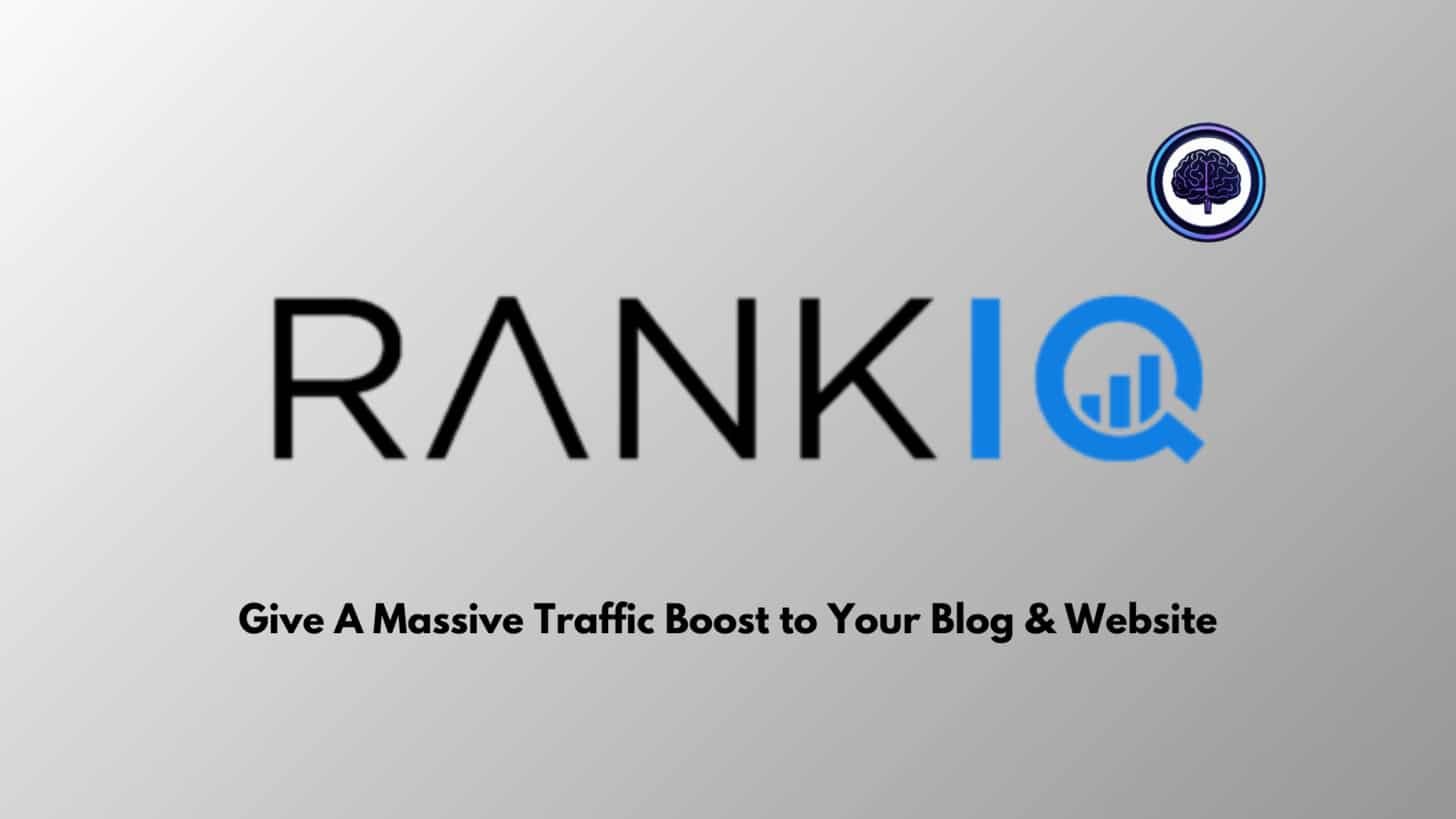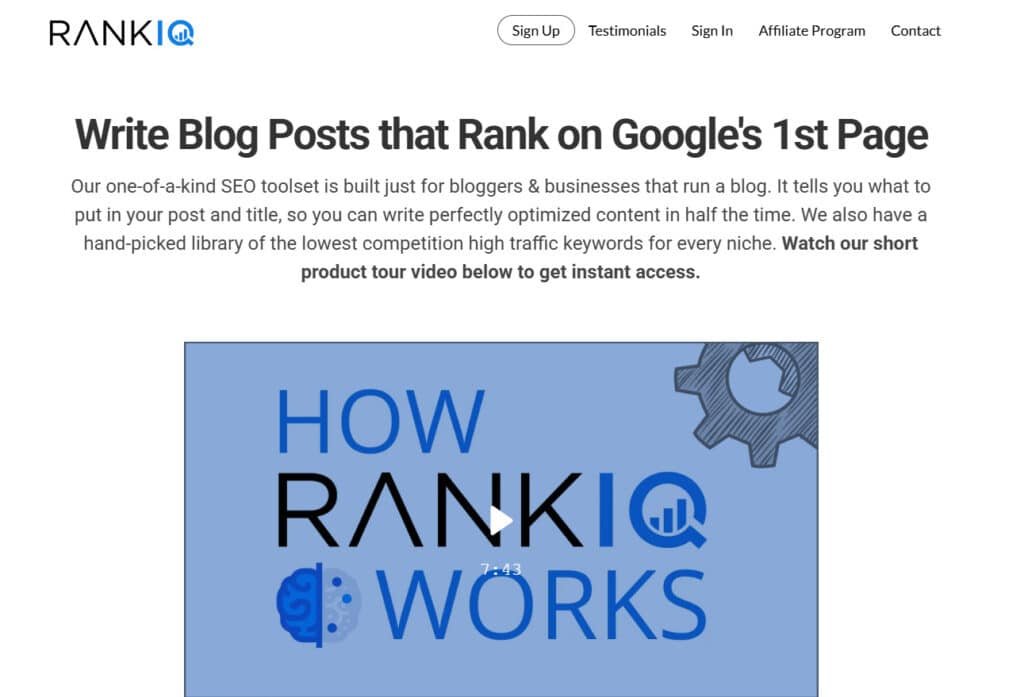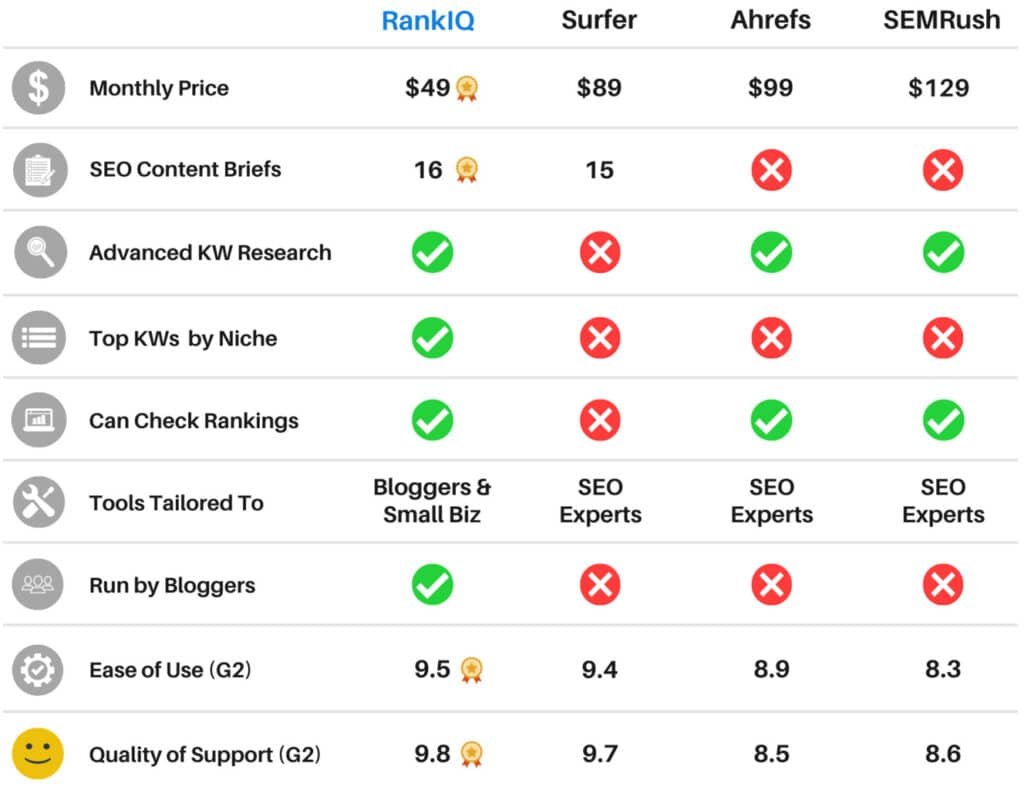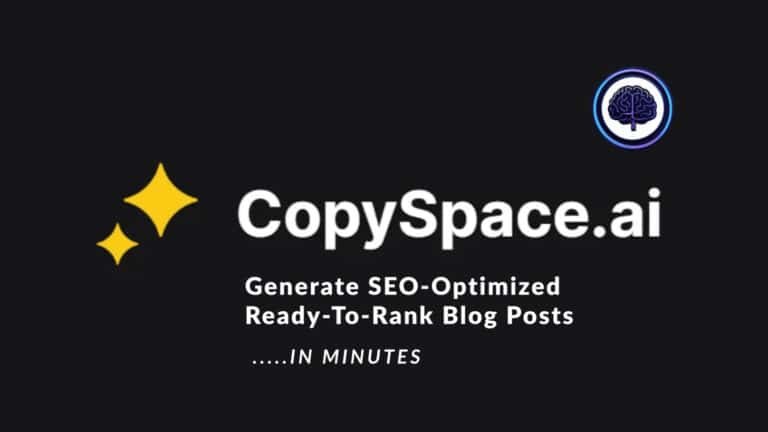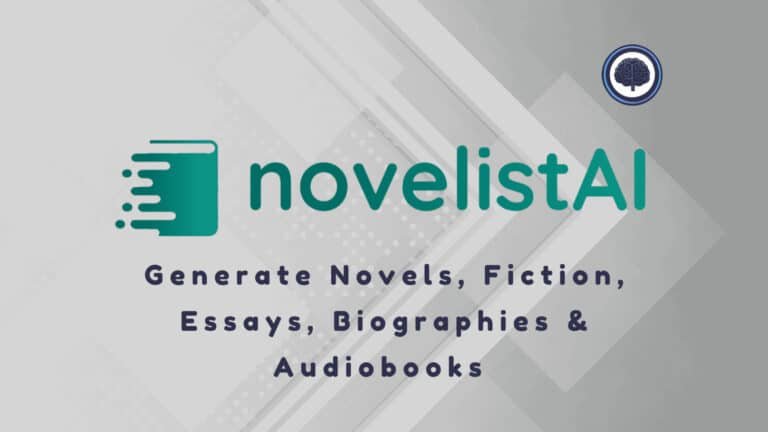Problem: If your content struggles to rank, you feel the squeeze—fewer pageviews, lower ad revenue, and endless keyword guesswork. I’ve been there. SEO can feel like a maze when you lack a simple, actionable process.
Agitation: You write posts, chase keywords, and wait—only to see slow gains. That wasted time costs momentum and morale. It’s easy to drown in dashboards or miss the keyword ideas that actually drive early traffic.
Solution: I wrote this rankiq review to show you a practical path forward. This tool bundles a hand-picked keyword library, content optimizer, and audits that tie into Google Search Console. I’ll share my hands-on results, timelines to rank, and how I pick winning keywords for a busy blog.
In short: expect an honest, optimistic take—what works, what doesn’t, and real data on traffic lifts. Let’s dive in.
Key Takeaways: RankIQ Review
- I test real workflows and share practical tips for faster ranking.
- The tool focuses on keyword selection and content grading.
- Expect clear timelines and metrics, including traffic impact.
- This review aims to help bloggers with limited time decide fast.
- Hands-on examples show how to use SEO reports and audits.
Introduction to RankIQ: Where It Fits in Today’s AI SEO Landscape
When search engines change fast, you want a tool that simplifies real work: research, write, publish. I’ve used tools that over-promised and I like practical help that saves hours.
RankIQ was created by Brandon Gaille — yes, the Blogging Millionaire behind the podcast. He built it to give bloggers and content creators a focused way to find low-competition keywords and optimize posts without enterprise budgets.
The platform emphasizes fast, useful guidance: curated keyword lists, on-page checks, and workflow steps that speed publishing. A Mediavine study found a 4.68x organic traffic increase among publishers actively using the tool — a solid signal for ad-driven sites.
- Founder: Brandon Gaille (Blogging Millionaire).
- Users: bloggers, content creators, and Mediavine publishers.
- Value: less time on keyword research and more time shipping content that matches intent.
| Focus | Audience | Benefit |
|---|---|---|
| Low-competition keyword research | Bloggers & content creators | Faster publishing and higher organic growth |
| Content optimization | Mediavine publishers | Improved RPMs and pageviews |
| Workflow efficiency | Solo operators and small teams | Less time wasted on guesswork |
RankIQ Review
I’ll guide you through what this 2025 product deep-dive covers and why it matters for your site. Expect a practical, hands-on look at features, pricing, benchmarks, pros and cons, who should use it, and clear alternatives.
What readers should expect from this 2025 product review
Scope: I test core tools, pricing tiers, and how I measure results in rankings, clicks, and time saved.
Timelines: Typical ranking ranges from the platform’s keyword library sit between 61–182 days. Some ultra-fast keywords hit the first page Google in 24 hours, but those are the exception.
Realities: Post-HCU updates are mixed—new posts and fresh sites usually see the best gains. Updating long-optimized posts can be hit-or-miss.
- I’ll walk you through core features and pricing and show ROI methods.
- We’ll set realistic expectations on time to rank and quick-win scenarios.
- Where it shines: new content workflow and structured optimization.
- Where it struggles: refreshing some pre-HCU content and niche gaps.
- Alternatives covered: SurferSEO, Frase, and NeuronWriter comparisons.
| Review Focus | Typical Timeline | Best Use |
|---|---|---|
| Keyword library & briefs | 61–182 days | New posts & small blogs |
| Content optimizer | Days to months | Structured optimizations |
| Rank tracking & audits | Ongoing | Monitor gains and ROI |
What is RankIQ?
I’ve used a lot of SEO tools, but this one bundles the core steps most bloggers need into a single, practical suite. It combines an expert-curated keyword library, a data-driven content optimizer, AI SEO reports, and a Rankings Audit that links to Google Search Console. The result is a compact workflow from idea to publish.
AI-powered keyword research, content optimizer, and planning suite
This tool scans top results and suggests LSI phrases, target word counts, and a content grade to hit. The rankiq keyword library focuses on low-competition opportunities hand-picked by experts — ideal when you’re short on time.
How it benefits new blogs and established sites post-HCU
For new blogs and fresh posts, the platform can accelerate early traction by highlighting quick-win keywords and providing clear briefs.
Established sites get value from the Rankings Audit and Blog Analyzer. Those features help you spot content decay and prioritize updates that actually move the needle in the search engine.
- Keyword library: curated, low-competition ideas.
- Content optimizer: LSI phrases, grades, and word-count guidance.
- AI SEO reports: timelines, title grades, and competitor headings.
- Rankings Audit: GSC integration to track and target drops.
How RankIQ Works: From Keyword to First Page Google
This section shows how a target keyword, proper word count, and Google data combine to move your pages up the rankings.
I start by choosing a target keyword from the library or a seed idea you already have. Then I run the report to get SERP insights and content targets.
The recommended word count is not guesswork. It comes from analyzing top-ranking competitors in Google Search—so you match depth, not fluff.
- Paste your draft into the editor and follow the LSI prompts until the content grade rises; higher grades correlate with better rankings.
- Connect Google Search Console so the Rankings Audit can surface pages with growth, contraction, top keywords, and content decay.
- Use that audit to prioritize updates—fix the worst pages first for the fastest lift.
I also tweak internal links and on-page elements while updating content. Some posts hit page one fast; typical timelines for library keywords sit around 61–182 days. Track progress weekly and optimize iteratively.
Best Features of RankIQ
Below are the standout features I rely on when I need fast, predictable gains. Each one saves time and maps to daily tasks: research, write, publish, and update.
1. Tailored SEO Toolset for Bloggers
The Tailored SEO Toolset for Bloggers is a core feature designed to simplify content creation for bloggers.
This SEO-focused system guides users step by step to craft a post that ranks high on search engines like Google. It provides precise instructions on what to include in a blog post and its title, ensuring optimization aligns with current SEO algorithms.
By streamlining the process, this feature reduces content creation time significantly.
For readers seeking to boost their blog’s visibility, this tool offers clear, actionable guidance to create a post that competes effectively in their niche, saving time while maximizing ranking potential.
2. Hand-Picked Keyword Library
The Hand-Picked Keyword Library is a curated collection of low-competition, high-traffic keywords tailored to every niche.
Users can select 2–3 RankIQ keywords per post, bypassing hours of manual research. This feature ensures keywords are both high-volume and achievable, perfect for ranking a blog higher.
Readers seeking efficient keyword strategies will benefit from this library, as it simplifies finding RankIQ keywords that drive traffic, making blog content creation faster and more effective for SEO.
3. Automated Keyword Discovery Engine
The Automated Keyword Discovery Engine identifies low-competition keywords with high traffic potential automatically.
This feature eliminates the need for tedious keyword research, delivering a list of actionable terms for any blog.
For readers aiming to scale their SEO efforts, this tool saves time by providing keywords that are easy to rank, ensuring each post targets terms that maximize visibility without requiring deep SEO expertise.
4. Traffic Potential Scoring
The Traffic Potential Scoring feature ranks keywords based on a proprietary score balancing traffic potential and competition.
It highlights “easy win” keywords for a blog post, ensuring optimal targeting.
Readers researching tools to improve their blog’s reach will find this feature valuable, as it prioritizes keywords that offer the best chance of ranking, helping drive more organic traffic to their posts efficiently.
5. Content Optimizer
The Content Optimizer suggests Latent Semantic Indexing (LSI) phrases, a content grade, and a recommended word count for each post. Users paste their draft, follow prompts, and improve the grade to align with Google’s algorithm.
This feature ensures a blog post is fully optimized for SEO. Readers looking to enhance their posts will benefit from clear, actionable suggestions that improve rankings, making content creation more precise and effective.
6. Old Post Optimization (Blog Analyzer)
The Old Post Optimization (Blog Analyzer) scans existing posts to identify those ready for a refresh. It suggests updates to keywords, structure, or depth to boost traffic for old posts.
For readers wanting to revive their blog archives, this feature pinpoints high-potential posts for optimization, helping reclaim lost rankings or improve current ones with minimal effort.
7. SEO AI Reports
SEO AI Reports estimate time-to-rank, grade titles, and analyze competitor angles for a post. These visual dashboards provide actionable insights to refine content.
Readers seeking data-driven SEO strategies will find this feature useful for setting realistic goals and crafting titles that outperform competitors, ensuring their blog ranks higher.
8. SEO Content Briefs
SEO Content Briefs generate outlines by identifying topics and subtopics Google prioritizes for a keyword. This feature enables users to create comprehensive post outlines in minutes. Readers aiming to streamline blog planning will benefit from this step-by-step guidance, ensuring their posts cover all necessary points to rank well.
9. Content Planner
The Content Planner sets monthly goals, such as 8 new posts and 8 updates, to maintain consistent blog growth. This feature organizes SEO efforts for efficiency. Readers looking to scale their blog will find this tool helpful for prioritizing tasks, ensuring steady progress in content creation and optimization.
10. SEO Title Generator & Analysis
The SEO Title Generator & Analysis creates optimized titles in 90 seconds, enhancing click-through rates with keyword-rich, engaging headlines.
This feature refines titles against competitors. Readers wanting better SEO performance will benefit from titles that attract clicks and rank higher, improving their blog’s visibility.
11. Rankings Audit & Tracker
The Rankings Audit & Tracker integrates with Google Search Console to monitor posts gaining or losing traffic.
It prioritizes fixes with high SEO potential. Readers seeking to maintain their blog’s performance will find this feature essential for identifying and addressing ranking issues, ensuring sustained traffic growth.
12. Traffic Growth Tracking
Traffic Growth Tracking monitors SEO performance for each post, benchmarking against real-user data.
A study showed using RankIQ led to 468% more traffic growth for Mediavine blogs. Readers aiming to measure their blog’s progress will benefit from clear analytics to track and improve rankings.
13. Competitive Benchmarking
Competitive Benchmarking compares a post to top-ranking pages, highlighting gaps to outrank them.
This feature ensures blogs target missed opportunities. Readers researching SEO tools will find this helpful for crafting posts that surpass competitors, boosting rankings effectively.
14. Study-Backed Validation
The Study-Backed Validation feature cites a study showing using RankIQ resulted in 468% more traffic for Mediavine blogs. Readers seeking proven tools will trust this data, ensuring their blog benefits from a reliable SEO solution.
15. Instant Access and Onboarding
Instant Access and Onboarding provides one-click signup and guided tutorials for immediate feature access. Readers new to SEO will appreciate this step for quickly starting to optimize their blog, making RankIQ user-friendly and efficient.
16. Visual Dashboards
Visual Dashboards display SEO data, like keyword performance and ranking progress, in interactive formats. Readers seeking clear insights will find this feature valuable for visualizing their blog’s SEO health, simplifying decision-making.
17. Founder Expertise Integration
The Founder Expertise Integration feature embeds insights from Brandon Gaille, a renowned blogger and SEO expert, into RankIQ’s algorithms.
One of the User’s blog attracts over 6 million monthly visitors and 100 million annually from organic Google search, with over 1,000 first-page rankings.
This expertise shapes the tool’s ability to recommend keywords and strategies that drive real impact.
Readers researching SEO tools will find this feature valuable as it leverages proven tactics from a top blogger, ensuring the keywords and optimizations suggested are grounded in real-world success, helping their blog rank higher without needing advanced SEO knowledge.
18. Product Tour Video
The Product Tour Video is a concise, on-demand resource that introduces RankIQ’s functionality.
Accessible directly on the homepage, it demonstrates how to use the platform to optimize a post and select keywords. This feature helps bloggers new to SEO quickly understand the tool’s capabilities without a steep learning curve.
For readers exploring RankIQ reviews, this video provides an immediate, visual guide to see how the tool can streamline their blog content creation process, enabling them to start using RankIQ effectively to enhance their post’s ranking potential from day one.
19. Highest-Rated SEO Tool
RankIQ’s Highest-Rated SEO Tool status, backed by multiple G2 SEO Awards, underscores its credibility.
This feature showcases user trust through badges and testimonials, proving its effectiveness for blog optimization. For readers searching for reliable tools, this recognition ensures they’re choosing a platform validated by industry experts, increasing confidence that using RankIQ will improve their post’s performance on Google.
The high ratings reflect its ability to deliver results, making it a go-to for bloggers aiming to elevate their SEO strategy.
20. Cost-Effectiveness
The Cost-Effectiveness feature positions RankIQ as a budget-friendly option that delivers premium SEO tools tailored for blog content.
It offers more features at a lower price than competitors, focusing on blogger-specific needs.
Readers looking to optimize their blog without breaking the bank will appreciate how using RankIQ provides access to advanced keyword research and content tools at an affordable rate, ensuring high-value SEO improvements for every post in their niche.
21. Ease of Use
The Ease of Use feature ensures RankIQ’s interface is intuitive, requiring minimal technical knowledge. Readers, especially beginners, will benefit from straightforward tools that make SEO and keyword optimization accessible, helping their blog succeed without complexity.
| Feature | Benefit | Day-to-day action |
| Keyword library | Faster keyword selection | Choose 2 targets per brief |
| Content optimizer | Higher content grade | Apply LSI prompts and adjust word count |
| AI SEO reports | Realistic timelines | Use title grades to refine headlines |
| Rankings audit | Catch content decay | Schedule updates for shrinking pages |
Pricing Plans of RankIQ
Costs boil down to capacity — how many AI SEO reports you use per month. Pick a tier that matches your publishing rhythm and update schedule.
Standard — $49 per month
This plan includes 16 reports or briefs. It’s great if you publish 4–8 posts monthly and run regular updates.
Pro — $99 per month
Pro gives you 36 reports. I use this when I publish weekly or my small team needs steady briefs and optimizations.
Agency — $199 per month
Agency includes 80 reports. It fits high-volume publishers or agencies managing multiple sites.
“All features are unlocked on every plan — you’re buying capacity, not tools.”
Credits reset each month and do not roll over. Plan your pipeline so you don’t leave reports unused.
| Plan | Price (per month) | Reports |
|---|---|---|
| Standard | $49 | 16 |
| Pro | $99 | 36 |
| Agency | $199 | 80 |
- Standard: Best for casual bloggers and small monthly output.
- Pro: Suits busy bloggers or small teams publishing weekly.
- Agency: Built for multi-site managers and agencies.
Bottom line: the plan you choose should reflect how many briefs and updates you run each month. This review helped me map weekly briefs so I use the full allocation every cycle.
Pros & Cons
Here’s a clear-eyed look at what works well and where the tool trips up. Below I list practical advantages first, then the real drawbacks so you can make a quick call.
Pros
- Curated, low competition keyword ideas save hours on discovery and get you targeting real quick-wins.
- Time savings: the workflow is built for busy bloggers—briefs, templates, and short onboarding.
- GSC integration: pull live search data to prioritize updates that matter now.
- All features unlock on every plan, plus strong tutorials and an active community that shortens the learning curve.
Cons
- Some ultra-narrow niches have patchy coverage; you may need extra manual research.
- Unused credits expire each month—plan sprints or you’ll lose capacity.
- Post-HCU, I’ve seen mixed results when re-optimizing already-optimized posts; new content often performs better.
Bottom line: You’ll save hours and get blogger-first workflows that improve everyday seo. If you need deeper audit granularity, explore the alternatives next. I’ve found using rankiq speeds up idea-to-publish for most sites.
Who Is RankIQ Best For?
If you run a small blog or juggle content solo, knowing when a tool will move the needle matters more than features. I’ve used it on sites that needed clear priorities, not more options.
Ideal users:
- New bloggers and solo content creators who need fast, low-friction briefs to publish consistent new content and build early traffic.
- Sites with large archives—use the Rankings Audit and Blog Analyzer to find which posts to revive first.
- Teams that want to delegate outlines: briefs include LSI prompts so writers hit topic depth and improve odds of the first page.
If you struggle to keep a steady cadence, the planner nudges you toward Brandon’s target (8 new + 8 updates monthly). That rhythm alone often beats sporadic publishing.
Short version: if you’re a busy blogger or manage many posts and want measurable gains in organic traffic, this is a tool to use rankiq for briefs and prioritization.
Alternatives
I tested several alternatives to see which tool pairs best with a blogger-first workflow. Below I map strengths, pricing signals, and when to pick each option so you don’t buy features you won’t use.
SurferSEO vs the blogger-focused option
SurferSEO has a deeper editor and Google Docs integration. It starts higher in price (~$89/month) and suits teams that need granular on-page analysis.
Frase vs hand-picked keyword library
Frase builds strong SERP-based outlines. It’s great for structured briefs, but its keyword research is not as curated as the library in the blogger product.
NeuronWriter and lifetime deals
NeuronWriter is attractive for one-time purchases and steady SEO suggestions. If you want a lifetime license, it can save money—though workflow integration varies.
Keysearch, Semrush, and Ahrefs
- These excel at deep research, site audits, and competitive analysis.
- Pairing one of them with a lightweight content workflow often gives the best-of-both-worlds.
| Product | Strength | Best For |
|---|---|---|
| SurferSEO | Editor depth, integrations | Agencies & teams |
| Frase | Outline builder | Writers needing SERP structure |
| NeuronWriter | One-time deals | Budget buyers |
| Semrush/Ahrefs/Keysearch | Granular data | Competitive research |
Bottom line: If you want quick wins, a curated library and simple workflow often beat a bloated suite. For deep analysis, add a granular research tool to your stack.
Real-World Results and Benchmarks
You want timelines and traffic evidence—here are the hard figures and what they mean. I compared internal claims, an industry study, and broader search data so you can set realistic goals for publishing and updates.
Mediavine study and publisher outcomes
Mediavine reports a 4.68x uplift in organic traffic for blogs actively using the platform’s workflow. That figure shows what steady publishing and targeted updates can do when you follow briefs and measure progress.
Typical timelines and external context
The product’s library often hits the first page Google in roughly 61–182 days for most targets. A few ultra-fast wins can appear in 24 hours, but those are exceptions—not the rule.
By contrast, an Ahrefs analysis found ~94.3% of pages reaching page one took over a year. That gap highlights the value of curated, low-competition keywords for faster rankings.
- Expect visible movement within a few weeks; consistent first-page visibility builds over 2–6 months.
- The 4.68x number demonstrates upside when you publish and update each month on a schedule.
- Ultra-fast outcomes happen, but plan using the average time frame above for steady results.
- Track clicks and impressions as well as positions—rankings without traffic rarely pay the bills.
- Use the Rankings Audit to validate gains and pick the next posts to improve.
“Measure both clicks and positions—search results tell one side of the story; traffic tells the rest.”
Case Study / Personal Experience
I treated the Rankings Audit like a treasure map — and worked from highest-risk pages down. I started by pulling the “Pages Experiencing Traffic Contraction” list and prioritized updates with the biggest upside. That gave me an instant roadmap.
I updated 13 old posts and tracked clicks, impressions, and average position in google search. The group saw roughly an 89% increase in total Google clicks. One single post exploded — a 26,900% traffic lift after optimization.
Day-to-day I ran a report, pasted drafts into the content optimizer, and pushed to an A/A++ grade. I checked rankings and clicks weekly; positions often moved first, then clicks followed.
- Pull Pages Experiencing Traffic Contraction from the audit.
- Run a report and use the content optimizer to hit A grades.
- Monitor clicks, impressions, and avg position each week.
- Ship updates fast — many fixes took hours, not days.
“The workflow let me ship updates in hours instead of days, and the results made the process easy to justify.”
Bottom line: this mix of updating archive content and launching new briefs delivered clear, measurable results for my sites.
Implementation Tips: Using RankIQ Day to Day
Keep your publishing engine humming with a simple, repeatable weekly rhythm. Batch work, protect your calendar, and measure small wins.
I start by queuing up 10 reports for top ideas, then pick the best target keyword for each brief. Build outlines from competitor headings and LSI terms, and set a clear word count and internal link goal.
Draft the blog post, then optimize inside the editor until the grade hits A or A++. Avoid stuffing—write for readers, not bots.
Publish, request indexing, and check position and clicks at two and four weeks. Track changes in time to rank and adjust headlines if CTR lags.
Reserve one day a week for updates. Pull the contraction list, triage by upside, and ship refreshed posts fast. Two focused sessions per week beat sporadic marathons.
A simple monthly cadence
| Site Type | Monthly Goal | Primary Action |
|---|---|---|
| Existing site | 8 new + 8 updates / month | Run reports, prioritize audits |
| New blog | 12–16 new / month | Batch briefs and publish fast |
| Ongoing | Weekly updates & checks | Monitor search metrics and adjust |
“Batch, optimize to A, and protect your calendar—that routine wins consistently.”
RankIQ Support, Training, and Community
Good support changes a tool from useful to indispensable when you’re in a publishing sprint. I found the onboarding and community resources shorten the learning curve and keep you moving.
Start with the intro video. It’s short, focused, and I recommend watching it before your first report. That one view saves time and prevents rookie mistakes.
What you get and how it helps
- Onboarding video: quick path to skills you need to ship briefs and hit grades.
- Mastermind Facebook group: active with bloggers and content creators sharing wins, playbooks, and fast fixes.
- Direct help: the in-app Help button routes questions to the team — Brandon Gaille and staff reply when you’re mid-sprint.
- Library maintenance: duplicates can appear during updates; support points you to the current stats on request.
“Treat the community as a workshop — your process will improve month over month.”
| Resource | What it does | Action to take |
|---|---|---|
| Intro video | Introduces workflows and best practices | Watch before your first report |
| Mastermind group | Peer support and playbooks | Ask questions; share wins |
| Help button | Direct support for issues and data questions | Use when you spot library duplicates or need quick clarity |
Conclusion
Here’s the bottom line for bloggers who need predictable SEO results fast.
I tested the workflow and the verdict is simple: this tool helps you plan, brief, and publish with less guesswork. The Mediavine data (4.68x organic traffic) shows the upside when you commit to a steady cadence.
Recommendation: start with the Standard plan ($49/month), commit to a 60–90 day testing window, and track weekly. That rhythm gives the best shot at the first page and steady gains.
The takeaway from this rankiq review: if you need a practical, blogger-first process to see real results, use RankIQ—ship your next piece this week and measure the lift.
Frequently Asked Questions
Who created this SEO tool and why does it matter?
The platform was founded by Brandon Gaille, a well-known blogging entrepreneur. By 2025 it matters because its feature set—keyword library, content optimizer, and planner—addresses post-HCU ranking challenges by focusing on low-competition keywords and content updates that can move pages toward the first page of Google.
Who typically uses this tool?
Bloggers, solo content creators, Mediavine and ad-driven publishers, and small agencies use it. I’ve found it’s especially helpful for sites with lots of posts that need keyword research, optimization, and regular updates to combat content decay.
What can I realistically expect from a product review of this tool?
Expect hands-on testing of keyword research, content briefs, and the content optimizer. A practical review shows time-to-rank benchmarks, results from updating old posts, and whether the keyword library delivers low-competition targets that can drive first-page Google results.
What exactly does the tool do?
It combines AI-powered keyword research, a hand-picked keyword library, a content optimizer (LSI phrases, suggested word count, content grade), rank tracking integrated with Google Search Console, and content planning to help you go from keyword selection to first page of Google.
How does it help new blogs compared to established sites after the Helpful Content Update?
For new blogs it provides focused, low-competition keyword options and content outlines to get traction faster. For established sites it helps revive old posts with the Blog Analyzer and targeted updates to recover or boost rankings post-HCU.
How does the keyword selection and word count guidance work?
The system suggests target keywords from a curated library and recommends word counts based on top-ranking pages. It emphasizes low-competition keywords and provides LSI and related phrases to improve relevance and depth for search engines.
Can I import Google Search Console data into the platform?
Yes. You can connect Google Search Console to import click and ranking data—useful for identifying pages to update and tracking progress after optimizations.
What are the best features to focus on first?
Start with the Hand-Picked Keyword Library for low-competition keywords, the Content Optimizer for briefs and suggested word counts, and the Rankings Audit/Rank Tracker to measure progress. The Content Planner is great for monthly goals and batching new content.
What does the AI SEO Report include?
The report offers timelines, suggested titles, competitor analysis, a content grade, and prioritized steps for optimization—useful for both new posts and resurrecting older pages that need attention.
How do monthly credits and pricing work?
Plans are tiered by monthly credits for reports/briefs—Standard, Pro, and Agency—with higher tiers offering more briefs per month. Credits are consumed when generating reports and typically don’t roll over, so plan your monthly workflow accordingly.
Is it affordable compared to SurferSEO or Clearscope?
It’s positioned as more affordable for bloggers—faster keyword research and focused features for content creators—though it lacks some advanced editor depth that enterprise tools provide.
What are the main limitations?
Limits include niche coverage gaps (some verticals see fewer low-competition finds), non-rollover credits, and mixed results on certain post updates—so you may need supplementary tools for granular research.
Who benefits most from using this tool?
New bloggers, solo creators, and sites with many existing posts to update benefit most—especially those seeking an integrated workflow for keyword research, briefs, and ongoing content planning.
How does it compare to SurferSEO, Frase, and NeuronWriter?
Compared to SurferSEO it’s simpler and more affordable but less deep in content editor features. Versus Frase it focuses more on a curated keyword library rather than automated outlines. NeuronWriter offers different pricing deals and workflows—choice depends on whether you prioritize hand-picked keywords or in-depth editor capabilities.
Are there real-world benchmarks showing impact on traffic?
Yes—case studies (including Mediavine publisher data) have shown multiples in organic traffic when the workflow is used consistently. Typical timelines for first-page results vary—some keywords move within weeks, others take months depending on competition and content quality.
What metrics should I track when using this tool?
Track clicks, impressions, keyword rankings, content grade, and page-level traffic. I recommend logging baseline Google Search Console metrics before changes and monitoring progress weekly after updates.
What daily workflow do you recommend?
A practical workflow: research hand-picked keywords, generate a brief, optimize content with suggested LSI phrases and word count, publish or update, then monitor with the rank tracker and Search Console integration. Batch tasks monthly to maximize per-month credits.
What kind of support and training is available?
There’s onboarding video content, a private community (Mastermind/Facebook-style group), and direct support channels. These resources help with onboarding and troubleshooting optimization questions.
Can this tool help revive old posts suffering content decay?
Yes—the Blog Analyzer and content optimizer are designed to identify decline patterns and provide targeted updates (titles, added sections, LSI phrases) that often restore or improve rankings when executed properly.
Are there better options for deep keyword research like Semrush or Ahrefs?
For granular, enterprise-level research Semrush and Ahrefs remain stronger choices. This platform is optimized for bloggers and creators who want a more guided, actionable approach to keywords and content briefs.

